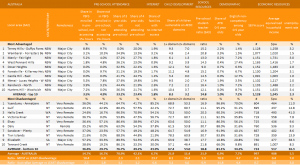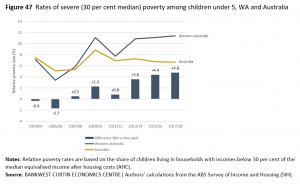Inequality drives deep divide between Australian children

— More than one third of disadvantaged children not attending preschool —
— One in five WA children under five living in poverty —
Children living in the most disadvantaged communities across Australia are far less likely to attend the required 15 hours of preschool and more likely to become developmentally vulnerable in their first five years of life, a new Bankwest Curtin Economics Centre (BCEC) report has found.
The Bankwest Curtin Economics Centre’s latest report, The Early Years: Investing in Our Future, reveals the extent of inequality of early learning opportunities across Western Australia and Australia.
The report shows that disadvantage starts during pregnancy and extends through toddlerhood and into preschool years, with significant differences in child outcomes evident across various domains including mental health, language development and early learning, well before formal school commences.
Report co-author and Bankwest Curtin Economics Centre Principal Fellow Associate Professor Rebecca Cassells said the report highlights the staggering divide between the most advantaged and disadvantaged areas in Australia and the impact this has on early childhood years.
“Children living in the most disadvantaged areas are 10 times more likely not to be accessing 15 hours of preschool each week in the year before school compared to children in the most advantaged areas, which brings into question how universal early learning opportunities really are,” Associate Professor Cassells said.
“They are also vulnerable across multiple development domains, far less likely to have access to the internet at home and if they are attending preschool, generally face higher student to teacher ratios.
“Access to early learning opportunities are providing positive outcomes for thousands of young children in Australia. Yet children facing greater disadvantage are the very ones missing out on the support that was ostensibly meant for them.”
Report co-author and Bankwest Curtin Economics Centre Director Professor Alan Duncan said the extent of very young children living in poverty in WA had also increased overtime, placing further pressure on these families.
“In WA alone, child poverty rates have been increasing over the last decade and currently more than one in five children under the age of five are living in poverty, with 11.4 per cent in severe financial hardship,” Professor Duncan said.
“This means that a single parent in severe poverty with a young child under five could face living on less than $370 a week after paying for housing.”
Professor Duncan said the report also found that the out-of-pocket costs of childcare contributes to an increased likelihood of poverty, even after childcare subsidies are factored in.
“This brings into sharp focus the question of adequacy of income support payments and government assistance, and the need to ensure that payments are set at a rate that serves to protect our most vulnerable population,” Professor Duncan said.
Report co-author and Bankwest Curtin Economics Centre Senior Research Fellow Dr Daniel Kiely said the report findings illustrate how important early intervention and support for mothers and babies are at the outset of pregnancy.
“Even though risky behaviour during pregnancy like drinking and smoking has decreased over time both nationally and in WA, we are still seeing high rates among some groups across Western Australia,” Dr Kiely said.
“The report also shows that an estimated one in four toddlers in WA display behavioural problems, and around one in six toddlers show social-emotional competence problems. Both rates are higher than the national average.
“Greater support is needed to make sure all children and their families, especially those living in disadvantaged and remote communities, have full access to services that will support families with very young children.”
The report also highlights the disproportionate numbers of Aboriginal and Torres Strait Islander children in child protection systems, with an Indigenous child aged between zero and four years old in WA 19.3 times more likely to be in out-of-home care than a non-Indigenous child.
Indigenous communities have experienced significant inter-generational trauma, disadvantage and hardship which has contributed to poorer life outcomes. Making culturally secure and trauma-informed intensive family support services available in these communities would help to improve early childhood outcomes.
Key findings from the report include:
- Almost 37 per cent of children living in the most disadvantaged areas do not access 15 hours of preschool each week in the year before school;
- One in two children living in the most disadvantaged areas are developmentally vulnerable on two or more domains, compared to the national average of 11.4 per cent;
- The most disadvantaged areas are all located in remote and very remote regions of Australia, across both Western Australia and the Northern Territory;
- Two-thirds of children in the most disadvantaged areas in WA are attending preschool for more than 15 hours compared to 85 per cent nationally;
- Children who attend preschool in the year before schooling are less likely to be developmentally vulnerable in their first year of school;
- WA also has the lowest proportion of children enrolled in centre-based day care preschool programs, at only six per cent, compared to 50 per cent nationwide;
- The 10 regions with the highest smoking rates during pregnancy are located in regional and remote areas of WA;
- More than one in five children under five in Western Australia (20.7 per cent) are living in families in poverty;
- The rate of severe poverty among children under five in Western Australia has risen to 11.4 per cent compared to a national rate of 6.7 per cent;
- A single parent with one young child in severe poverty has to live on less than $370 per week after taking into account housing costs;
- Almost 30 per cent of toddlers from households living in severe poverty were estimated to have delays in language development;
- Nearly 30 per cent of children enrolled in preschool are accessing less than 15 hours of preschool each week in the year before commencing formal schooling in Western Australia;
- Only one in two Indigenous children in WA are accessing more than 15 hours of preschool each week, compared to 70 per cent of non-Indigenous children; and
- Indigenous child aged between zero and four years old in WA 19.3 times more likely to be in out-of-home care than a non-Indigenous child.

Source: BANKWEST CURTIN ECONOMICS CENTRE| Authors’ calculations from BCEC Early Learning Disadvantage Index









